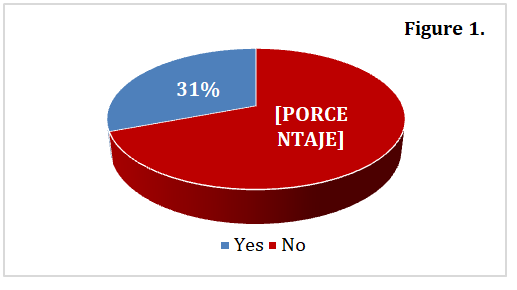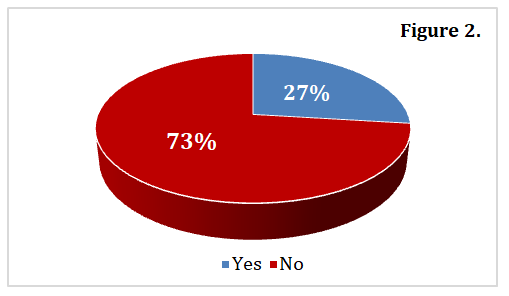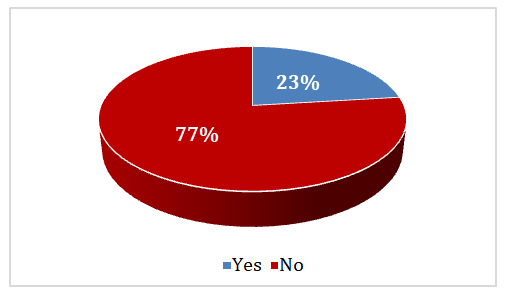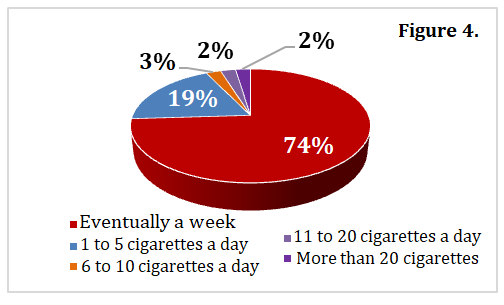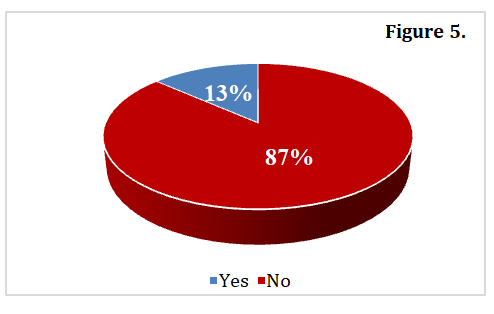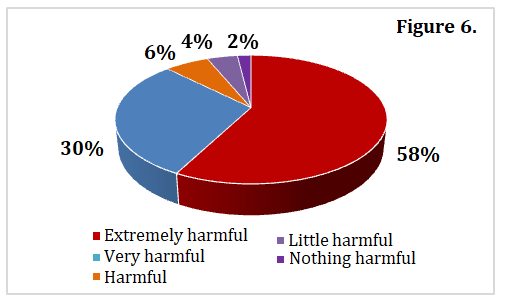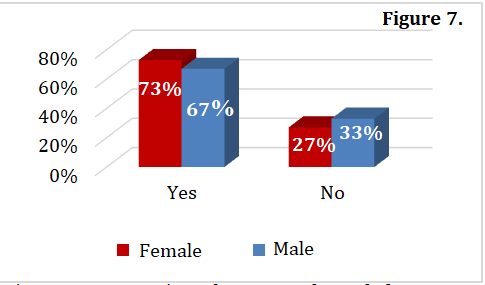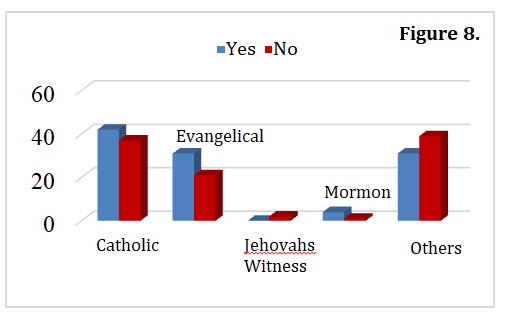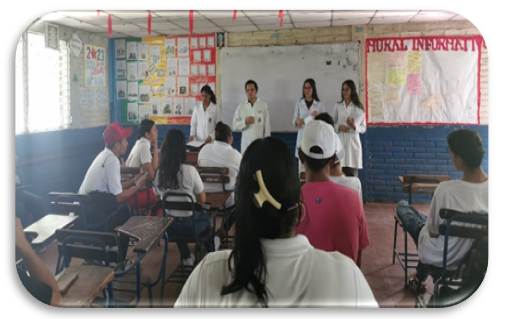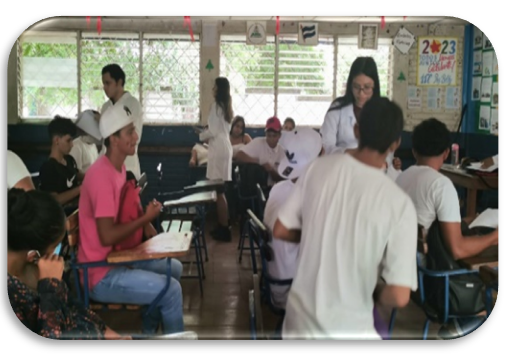Previous Issues Volume 5, Issue 6 - 2023
Family Factors and Personal Determinants of Tobacco Consumption, Students from Ninth-Eleventh, Instituto San Nicolás, La Paz Centro, III Quarter, 2023
Rocha Peña Víctor Saúl1,*, Benedicht Jarquín Kenal Jafet2, Castillo Paredes Ana Massiell2, González Munguía Odeth de los Ángeles2, Matute Zapata Kathy Guissell2
1Licenciado en ciencias de Enfermería, Docente del Departamento de Enfermería. Miembro de la comisión de Vicerrectoría de Innovación y emprendimiento en enfermería, miembro del Comité de Investigación y Desarrollo en Enfermería, CIDE – UNAN León, Nicaragua
2Bachilleres en ciencias y letras, estudiantes de Enfermería, Dpto. Enfermería, Facultad de Ciencias Médicas, UNAN-León, Nicaragua
*Corresponding Author: Rocha Peña Víctor Saúl, Licenciado en ciencias de Enfermería, Docente del Departamento de Enfermería. Miembro de la comisión de Vicerrectoría de Innovación y emprendimiento en enfermería, miembro del Comité de Investigación y Desarrollo en Enfermería, CIDE – UNAN León, Nicaragua; Email: [email protected]
Received Date: November 07, 2023
Published Date: December 10, 2023
Citation: Saúl RPV, et al. (2023). Family Factors and Personal Determinants of Tobacco Consumption, Students from Ninth-Eleventh, Instituto San Nicolás, La Paz Centro, III Quarter, 2023. Mathews J Nurs. 5(6):31.
Copyrights: Saúl RPV, et al. © (2023).
SUMMARY
Tobacco consumption is a chronic non-communicable and addictive disease, with possibilities of treatment and cure. In adolescence it constitutes a public health problem, since tobacco is highly addictive and becomes a problem that destroys the life of the consumer. It contains psychoactive substances that affect the functioning of the brain and nervous system, it has harmful effects on the respiratory system, affecting the bronchi and lungs.
The problem of tobacco consumption lies in how susceptible the adolescent is to being part of the consumer group. This could be influenced by family factors such as lack of communication and supervision or having a user at home, as well as personal determinants such as an impressionable personality or Ignorance of the consumption that tobacco entails.
The study was descriptive, quantitative and cross-sectional where the population was made up of 208 young people between the ages of 12 and 20, students from ninth to eleventh grade, of both sexes, in the morning and afternoon shifts of the San Nicolás Institute, La Paz Centro.A data collection instrument was applied on family factors and personal determinants of tobacco consumption. For the participants, the act of consuming tobacco is of utmost concern, since it occurs at home in the family circle, there is no consumption limit since they access it through places close to the study center, where there is no restriction policies. Even though they know the risks and perceive that they are not accepted by society, they continue to carry out this practice.
Keywords: Tobacco, Consumption
INTRODUCTION
The World Health Organization (WHO) has classified smoking as a chronic non-communicable and addictive disease, with possibilities of treatment and cure. Tobacco use is one of the greatest threats to public health that the world has ever had to face. It causes more than 8 million deaths a year, of which approximately 1.2 million are due to exposure to second-hand smoke [1,2].
Tobacco consumption is an intense problem in America, since it causes at least 845,000 deaths per year. In addition, it is considered to cause more than fatal and disabling diseases, such as bronchial, lung and laryngeal cancer, cardiovascular diseases and emphysema, representing approximately 54% of the total disease burden in the region [3].
Brazil is one of the largest tobacco growers and exporters in the world. The deadly effects of the population's exposure to tobacco consumption are already clearly manifested, referring to the increasing rate of deaths from lung cancer. The prevalence of tobacco consumption in men is 39.9% and in women, 25.4% [4].
Nicaragua, being a volcanic country, its soil is very rich, with nutrients 35 and minerals that allow the tobacco plant to grow in many areas of the country. There are more than 60 companies dedicated to the production of premium cigars, of which 25 represent 95% of exports. The current prevalence of tobacco consumption is 5.3 in adult women; while in young women it is 20.5 and in young men it is 30.4; for a prevalence in young people 39 of 25.1 [5].
From another point, León, a department of Nicaragua, is not exempt from tobacco consumption; Leonese residents have a high incidence of this practice. The Nueva Vida Group (Narcotics Anonymous) is located in the San Felipe neighborhood, a non-profit association, which provides support for the reduction of smoking and leads to improvements in the quality of life and healthy environments [6,7].
In the municipality of La Paz Centro, León-Nicaragua, tobacco consumption has not been quantified; however, it is evident through the movement of its commercialization and the visibility of smokers on the street and even in study centers, where there is a greater frequency of adolescents.
Canales N. and Areas H., in July 2016, carried out a study on the personal and social factors related to tobacco consumption in high school students, obtaining as a result that tobacco is becoming a problem that is affecting adolescents. Using consumption as a distraction or to attract attention without measuring the consequences it brings to their lives [8].
In 2017, Alvarado K, carried out a study in the department of Estelí where a high incidence of smoking was demonstrated, so the health program is trying to reduce tobacco consumption, to achieve a better quality of life and in this way eradicate the exclusive consumption by people with different problems that lead to tobacco consumption without measuring future complications [9].
Caballero C, Mayorga Y, in April 2019, indicated that in Latin America smoking causes approximately 430,00060 deaths each year, according to WHO reports. In addition, it is related to the appearance of approximately 29 diseases in which 10 different types of cancer can be found, and the main cause of 95% of lung cancer, 90% of bronchitis and more than 50% of cardiovascular diseases [10].
The beginning of tobacco consumption in adolescence is a public health problem because tobacco is highly addictive, comparable to pure drugs, since it contains psychoactive substances that affect the functioning of the brain and nervous system.Additionally, tobacco is known for its harmful effects on the respiratory system, causing significant damage to the bronchi and lungs that can lead to diseases such as chronic bronchitis, emphysema and lung cancer [11].
The problem of tobacco consumption lies in how susceptible the adolescent is to being part of the consumer group, this could be influenced by family factors; such as the lack of communication and supervision or having a user at home, personal determinants such as the person's impressionable personality or lack of knowledge of what tobacco consumption entails can also be linked to this action.
Based on the above, the following research question is raised:
What are the family factors and personal determinants of tobacco consumption in students from ninth to eleventh grade, Instituto San Nicolás, La Paz Centro, III Quarter, 2023?
Raising our next objective: Describe the family factors and personal determinants of tobacco consumption in students from ninth to eleventh grade, Instituto San Nicolás, La Paz Centro, III Quarter, 2023.
MATERIALS AND METHODS
A quantitative, cross-sectional descriptive study was carried out. Descriptive: Because it addressed the data obtained in greater depth. Quantitative: Because it allowed the data obtained to be reflected and evaluated according to the results. Cross section: Because it allowed a cut in time during the study period. The study was carried out at the San Nicolás Institute, La Paz Centro, León. Located in the Manuel Velázquez neighborhood, from the mayor's office 3c down, 2 south. The limits are: To the north: Apocalypse 3:20 Church, to the south: Municipal Stadium, to the east: Los Cocos neighborhood, to the west: Empty property.
Regarding the universe, all students from ninth to eleventh grade, of both sexes, from the morning and afternoon shifts of the San Nicolás Institute, La Paz Centro, León. For a total of 436 students, applying the formula to calculate a finite population sample on the total of 208 surveys to be carried out.
Sample
n= Z2 × P × Q × N/ (e)2 (N-1) + Z2 × P × Q N= Total population (436 students).
P= Proportion of occurrence in the event 50% (0.5)
Q= Complement of P (1-P)= 1-0.5
Z= Confidence level.
n= 1.96² × 0.5 × (1-0.5) × 436 / (0.05)² × (436-1) + (1.96)² × 0.5 × (1-0.5)
n= 208
The primary sources of information, surveys with closed questions obtained from students from ninth to eleventh grade of the San Nicolás Institute, La Paz Centro, León. Also, the secondary sources of information such as magazines, theses, monographic works, research articles, biomedical journals, websites.
One of the methods used to evaluate the surveys was the Likert scale.
Taking into account the inclusion criteria that the participants are active students, they must be from ninth to eleventh grade, smoke or have ever smoked, who wish to participate in the study.
The dependent study variable is Tobacco consumption and the independents variables are Family factors and Personal determinants.
For data collection: To access the information, a letter was delivered to request permission and authorization to the director of the San Nicolás Institute, explaining the objective of the research to obtain necessary information, and a survey was applied to students from ninth to eleventh grade, the purpose of the study was established and that the information provided will be confidential.
The data collection technique and instrument: Information collection was carried out through a survey with closed and open questions regarding sociodemographic data, family factors, and personal determinants of the San Nicolás Institute, La Paz Centro, León. The pilot test was carried out on 10% of the sample, corresponding to 20 students from ninth to eleventh grade in the Saturday modality of the San Nicolás Institute, La Paz Centro, León. that have similar characteristics to the study population, allowing the validity and reliability of the instrument to be verified.
After completing the surveys, the data collected was processed through the statistical program SPSS version 21, data that were presented in simple tables.
With respect to ethical aspects, a letter of consent and informed assent was made and given to each participant where the objective of the research was explained. It was explained to the participants that the information would be anonymous and very useful for research purposes.
The participant made the decision to cooperate or withdraw at any time they desired. The information provided was handled solely by the research team and used for research and academic purposes.
RESULTS
The study population was 208 students, of which the majority are male with 57%, the participants are between the ages of 12-15 years, 38% identify with the Catholic religion, and it was observed that Urban origin predominates with 75%. 37% are in tenth grade and 70% are part of the morning shift.
Regarding the family factors, tobacco consumption within the family circle, 145 respondents (69.7%) reported that they do have a family member who uses tobacco, and 63 people for 30.3% responded that they do not have a family member who uses tobacco. See figure 1. Does any member of your family use tobacco?
In consideration of the need for identification to verify the age of majority when purchasing tobacco, 27% (56) of respondents responded yes and 73% responded that they do not need identification to purchase. See figure 2. Do they ask for identification to assess their age of majority?
In relation to the knowledge that the family of the study participants has about whether they have ever used tobacco, 77%, 160 participants, responded no and 23%, that is, 48, responded yes. See figure 3. Does your family know that you smoke?
Regarding the personal determinants, frequency of consumption of tobacco by the respondents, 74%, 154 respondents responded to consume cigarettes occasionally a week and 19%, 39 Respondents responded that they consumed 1 to 5 cigarettes a day. See figure 4. How many cigarettes do you consume regularly?
Regarding the knowledge of young people about the consequences of tobacco consumption, 86% reported that they do know the consequences and 13% reported not knowing them. See figure 5. Do you know the consequences of consuming tobacco?
According to the perception that the participants have regarding the consequences of tobacco consumption, 58% responded that it is extremely harmful, equivalent to 120 respondents, and 30% (62) responded that consuming tobacco is Very harmful. See figure 6. How harmful do you think consuming tobacco can be?
Contingency Tables
Contingency table Sex * Does any member of your family use tobacco?
When relating the sex of the respondents and whether any member of the family consumes tobacco, the data show that for women 73% of family members consume tobacco and 27% do not, while for men 67% of family members consume tobacco and 33% do not. See figure 7.
Contingency table Religion* Do your parents/guardians control your habits?
Based on the relationship of religion with the control of habits of the participants, 20% of Catholics claim to have control of habits by their parents/guardians and 18% do not and 15% of the participants of other religions report being controlled regarding their habits and 19% were not.See figure 8.
Image 1
Image 2
DISCUSSION
According to the sociodemographic aspects, the trend is 16 years old and the average is 16 years old, the male sex, Catholic religion and urban origin predominate, tenth grade and morning shift prevail. It is proven through the National Institute on Drug Abuse, which establishes that men consume tobacco in greater quantities than women. In 2020, it is shown that 37% of men and 8% of women. Regarding age, it is also justified, since, between 12 and 18 years of age, the young person begins to consume tobacco regularly.
Regarding tobacco consumption at home, it is reflected that 69.2% of the participants have witnessed tobacco consumption in their home, however, 30% express that they do not smoke in front of them, this information is corroborated by García Roche which states that any behavior or exposure to a risk factor of a family member can influence the entire family and fundamentally, the most vulnerable individuals, among which are adolescents.
When evaluating the need for identification to verify the age of majority when purchasing tobacco, 27% responded yes and 73% denied the need for identification, which is contradictory to what is established by the Tobacco Control Law, No. 727, in its Art. 2: Purposes of the Law, in section 6: Prohibit the sale and consumption of tobacco or tobacco products to minors, and require sellers to apply sales policies that guarantee compliance with this prohibition.
In relation to the knowledge that the family of the study participants has about whether they have ever used tobacco, 77% answered no and 23% answered yes, which is proven by the Santander Sylvia study, which shows that 66.5% of the participants perceive that their families are dysfunctional. Almost half of the schoolchildren involved in this study state that their parents do not dedicate adequate time to talk, in addition, they report a lack of knowledge of their children's activities.
Regarding the frequency of consumption of tobacco by the respondents, 74% stated that they consum cigarettes occasionally a week and 19% responded that they consume 1 to 5 cigarettes a day, this diverges with the research of Baltasar Alicia, the which reflects that the substance most consumed daily among adolescents is tobacco and 3 out of 10 adolescents consume it daily.
Regarding the knowledge of young people about the consequences of tobacco consumption, 86% reported that they do know the consequences and 13% reported not knowing them, contradicting Holford, who highlights that the poor approach to the negative consequences of smoking, mainly favors the establishment of tobacco consumption.
According to their knowledge of tobacco consumption, 58% responded that it is something extremely harmful and 30% responded that consuming tobacco is very harmful. This is related to the study by Arieta Vergara, which observed that a total of 90% agree with the severity of the smoking habit, considering cancer the most common disease in this practice.
CONCLUSION
Regarding the descriptive study on “Family factors and personal determinants of tobacco consumption in students from ninth to eleventh grade, Instituto San Nicolás, La Paz Centro, III Quarter, 2023” it can be concluded that:
In relation to the sociodemographic data, the study population was made up of 208 students from ninth to eleventh grade of the San Nicolás Institute, La Paz Centro, the age group of 12 to 15 years predominated, with an average age of 16 years, mode 16 years old. Mostly male and Catholic; More than half of the study population comes from the urban area and belongs to the morning shift.
Regarding family factors, it was determined that the students mostly live with relatives who consume tobacco, whose relationship stands out as uncles, they have predominantly smoked in front of them and they have a lot of trust in their family circle.
The most prevalent form of tobacco consumption is cigarettes, it was found that more than half of the participants report having accessibility to buy tobacco near their study center, in turn, that they do not request identification when making the purchase; Most of the participants admit that their family is not aware of their tobacco consumption even though their parents or guardians monitor their habits.
Regarding the personal determinants, it was identified that the participants relate to friends who smoke; Furthermore, they report that they deny accepting cigarettes from their friends; A large part of those surveyed are used to smoking occasionally, the majority do know the consequences of consuming tobacco and recognize that it is extremely harmful.
It is highlighted that more than half of the participants do not feel accepted for smoking, nor do they consider themselves mature people for smoking; Likewise, consuming tobacco does not help them forget their problems, it does not give them a feeling of relaxation; They report that smoking tobacco does not help them defecate or relieve their pain, it does not cause them anything to stop using tobacco for a long time.
With the present investigative study, significant information was obtained, which highlights the magnitude that this action brings to adolescents. Family factors and the environment directly influence the actions and decisions of adolescents, as well as the personal determinants that prevail and lead to irresponsible tobacco consumption. Tobacco consumption is one of the greatest threats to public health worldwide, which is truly worrying due to the early onset of this practice.
REFERENCES
- Cardentey García J. (2016). El tabaquismo: un flagelo nocivo para la humanidad. Archivo médico Camagüey: 20(2):114–117.
- Organizacion Mundial de la salud. (2023). Tabaco. Who.int. https://www.who.int/es/news-room/fact-sheets/detail/tobacco
- Valdés-Salgado R, Hernández Avila M, Sepúlveda Amor J. (2002). El consumo de tabaco en la Región Americana: elementos para un programa de acción. Salud pública de Mexico. 44:s125–s135.
- PAHO/WHO. (1992). Tabaco o Salud en las Américas. Paho.org. https://iris.paho.org/bitstream/handle/10665.2/3320/Tabaco%20o%20salud%20situa
- Organizacion Panamericana de la Salud. (2013). Prevención y Control de Enfermedades Análisis de Salud. Paho.org. https://www3.paho.org/nic/dmdocuments/Boletin%20Informativo%20sobre%20Tabaco.pdf
- Narcotics Anonymous World Services Inc. (s/f). ¿Qué es el programa de Narcóticos Anónimos? Org.ar. Recuperado el 2 de diciembre de 2023, de https://www.el-libro.org.ar/wp-content/uploads/2022/04/%C2%BFque%CC%81-es-el-programa-de-na_.pdf
- Narcotics Anonymous World Services, Inc. (s/f). GRUPOS DISPONIBLES – NARCOTICOS ANONIMOS. Narcoticosanonimosnic.com. http://www.narcoticosanonimosnic.com/grupos-disponibles/
- Figueroá NC, Flores HA. (2016). Factores Personales y Sociales relacionado al consumo de tabaco en estudiantes de undécimo grado Instituto Nacional Público Señor Esquipulas, Telica, Mayo - julio, 2016. unanleon.edu.ni. http://riul.unanleon.edu.ni:8080/jspui/bitstream/123456789/6442/1/234012.pdf
- Alvarado K, Pineda A, Epidemiología WM. (2008). Factores Asociados A La Iniciacion Del Consumo De Tabaco En Los Estudiantes Adolescentes Del I Al III Año De Los Colegios De La Zona Noroeste Del Distrito V Del Municipio De Managua En El III Trimestre Del Año 2008. https://repositorio.unan.edu.ni/6851/8/t454.pdf
- Claudia E, Caballero M, Enf R, Yaritza EM, Canales F. (2018). Razones y consecuencias del consumo de tabaco en estudiantes de 2do a 5to año del Instituto Nacional Señor de Esquipulas, Abril- Junio, Telica-Leon 2018. unanleon.edu.ni. http://riul.unanleon.edu.ni:8080/jspui/bitstream/123456789/7784/1/244721.pdf
- Gonzalez Henriquez L, Berger Vila K. (2002). Consumo DE Tabaco en adolescentes: Factores 0de Riesgo y factores protectores. Ciencia y Enfermería (Impresa). 8(2):27–35.
